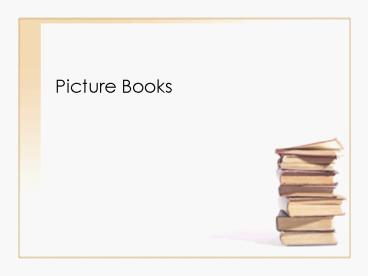Picture Books PowerPoint PPT Presentation
1 / 26
Title: Picture Books
1
Picture Books
2
Questions
- What is a picture book?
- What types of picture books are there?
- What are the characteristics of good picture
books? - How will we use picture books for instruction?
3
What are they?
- Product of the twentieth century
- Support early learning
- profusely illustrated in which words and
illustrations contribute to the storys meaning - Different than illustrated books
4
What are they?
- Tale told in two media
- An integration of visual and verbal art
- Illustrations add plot or concept information
- Illustrations add clues to character traits,
settings, and moods
5
Review a picture book
- Use the criteria on pp, 76-77 to discuss the
characteristics of a book with your neighbor - Will the book provide balance between what the
child enjoys and what you want to lead them to
enjoy?
6
History of Picture Books
- Rare and expensive-very few written for children
- Viewed as tools for educating and saving the soul
(not for enjoyment) - Color printing made books more affordable
- Children no longer viewed as little adults who
had to behave and work accordingly
7
Picture Books Today
- Well established genre
- High levels of conceptual difficulty and artistic
sophistication for middle level and junior high
students - Bilingual texts
- Books that emit sounds or talk
- Interactive CD Rom books
8
Baby/Board Books
- Simple design
- Brightly illustrated
- For children 0-2
9
Interactive Books
- Stimulate verbal or physical interaction
- Asks direct questions or invites recitation
- Encourages clapping or movement to the rhythm
- Asks the child to touch or manipulate items
- Ages 2-6
10
Toy Books
- Engineered or mechanical books
- Pop-ups, moveable, changeable, or
three-dimensional illustrations - Fragile or elaborate pop-ups are appropriate for
older students or adults
11
Wordless Books
- No text or very little text
- Illustrations must be very narrative
- Ages 4-6
- Children read the illustrations in their own
words
12
Alphabet Books
- Presents alphabet letters, names, and or sounds
- Consider the appropriateness of the theme, use of
uppercase and lowercase letters, appropriate font
and readable text
13
Counting Books
- Numbers 1-10 are introduced along with shape and
name, quantity represented, and counting sequence - Interesting items to count are illustrated
14
Concept Books
- Picture books that explore or explain an idea or
concept - Do not tell a story
- No plot but repeated elements throughout the book
- Naming books present simple pictures with labels
15
Pattern Books
- Predictable books that rhyme, repetition, and
illustration clues to support the reader - Natural sounding familiar language
16
Picture Storybooks
- Illustrations and text are equally important in
telling the story - Intended to be read aloud
- Ages 4-7 and 8 and up
- Millions of Cats by Wanda Gag was the first
picture storybook (1928) - Peter Rabbit (1902) by Beatrix Potter in England
was the first modern picture storybook
17
Easy-to-Read Books
- Limited text on each page
- Large print, double spacing, and short sentences
- Lots of illustrations
- Usually controlled vocabulary
- To be read independently (unlike picture
storybooks) - May be divided into short chapters
18
Picture Books for Older Readers
- More sophisticated, abstract, and complex theme,
story, and illustrations - May include picture storybooks, wordless books,
toy books, and informational picture books
19
Transitional/Chapter Books
- For children who can read but are not yet fluent
readers - Between picture books and full length novels
- Uncomplicated writing style and vocabulary
- Illustrations on every third page
20
Caldecotts
- The most distinguished picture book for children
published in the previous year. Established in
1938. Given to a U.S. illustrator.
21
Developing Visual Literacy
- Ability to sort through images and develop a
sense of discretionary viewing and judgment - Develop a sense of personal taste in
illustrations - Become aware of illustrations and become
sensitive to discriminating - Teachers must learn about style, medium, design,
and illustrators
22
Overall Book Design
- Size and shape
- Book jacket
- End papers
- Front matter
- Lettering
- Placement of art and text on the page
- Blend of text and illustrations
23
Artistic Style
24
High Five Strategy
25
(No Transcript)
26
(No Transcript)

